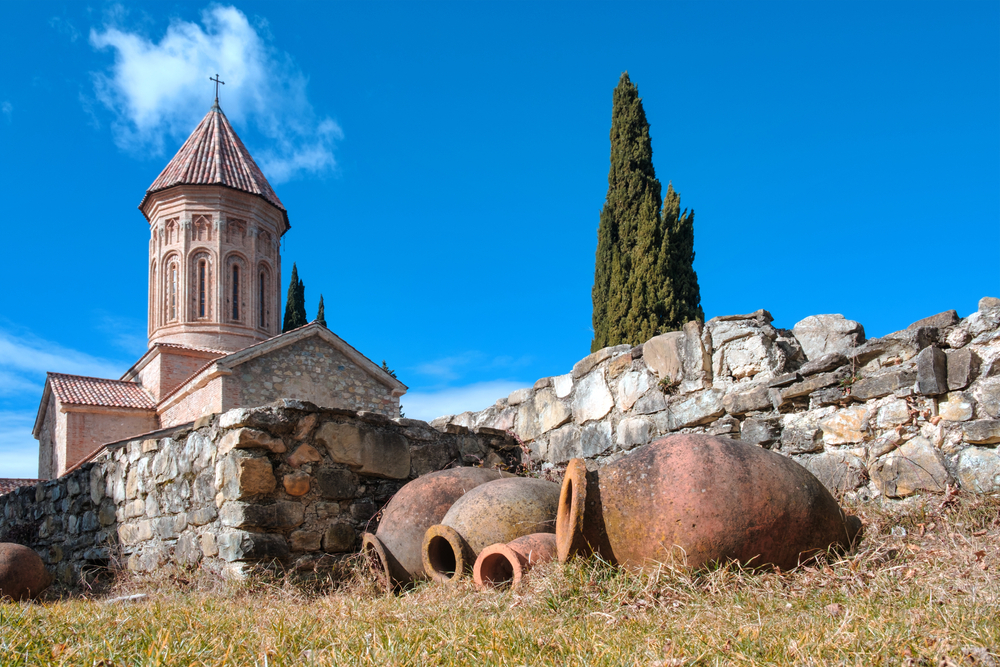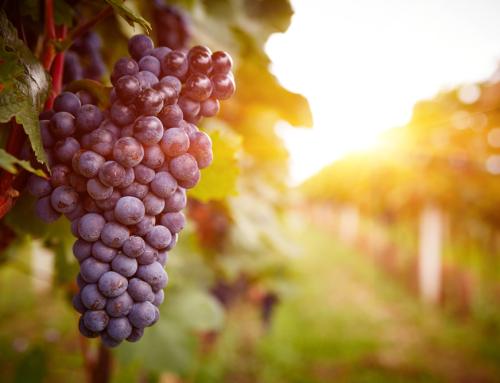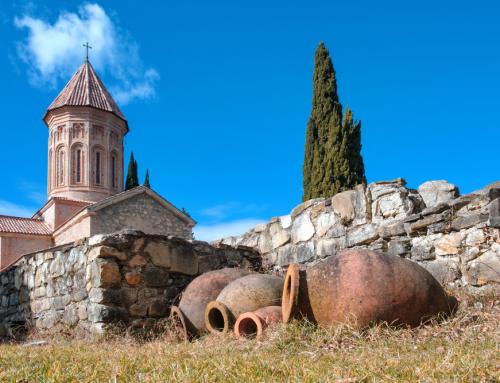Georgia’s diverse natural conditions create the best environment for the development of high quality viticulture-winemaking according to the peculiarities of which the country’s territory is divided into the following viticulture zones and micro-zones:
• Kakheti. Sub-zones: Shida Kakheti, Gare Kakheti;
• Kartli. Sub-zones: Kvemo, Shida and Zemo Kartli;
• Meskheti;
• Imereti. Sub-zones: Upper Imereti, Middle Imereti, Lower Imereti;
• Racha-Lechkhumi. Subzones: Racha, Lechkhumi;
• Black Sea Coastal zone. Subzones: Adjara, Guria, Samegrlo, Abkhazeti.
Approximately 65-70% of all Georgian vineyards are cultivated in the ancient and unique viticulture-winemaking region of Kakheti. Kakheti is the most important Georgian winemaking region. The vineyards giving the best quality wines are located in the Alazani and Iori basins, at 400-700 m asl, on humus-carbonate, black and alluvial soils. Of 18 aboriginal wines registered in Georgia 14 belong to Kakheti, such as Tsinandali, Gurjaani, Vazisubani, Manavi, Kardanakhi, Tibaani, Kakheti, Kotekhi, Napareuli, Mukuzani, Teliani, Kindzmarauli, Akhasheni, Kvareli. Among grape varieties there should be noted: Rkatsiteli, Kakhuri Mtsvane (Kakhetian Green), Qisi, Khikhvi, Budeshuri, Mtsvivana, Sapena, Kunsi, Saperavi, Cabernet-Sauvignon, Tavkveri, Ikalto Red, etc. Among Georgian wines Kakhetian wine expresses soil properties most of all. High quality wines are made Kakhetian grape varieties using both European and traditional wine making technology. Kakhetian traditional wine technology has no analogy in the world. The basic technological process consists in pressing grape in a Satsnakheli (winepress) and pouring the grape must (badagi) in the qvevri. After completion of alcoholic fermentation the “chacha” (grape skins, stalks and pips) sinks to the bottom and the qvevris are closed and after malolactic fermentation the qvevris are closed hermetically. In March the first racking occurs. After that wine is aged for about a year and systematically controlled. In addition to traditional Kakhetian wine, a very good European-style wine can be also made Kakheti grape varieties. For example, Rkatsiteli and Kakhetian Mstvane classical Georgian Tsinandali can be made. The most wide-spread grape variety in Kakheti is Saperavi. Saperavi is made both qvevri and European-style wines. Saperavi is used to produce wonderful pink and sparkling wines. For centuries Kakheti has created and formed an original type of table wine which is rather distinct the wine of this type around the world. It is characterized by high extraction, a high content of phenolic compounds and tannins, pleasant bouquet, sort-specific aroma and taste.
Kartli is one more notable wine making region in Georgia. It is known for its classic European style and high-quality sparkling wines. The vineyards are cultivated in extensive basins of the rivers – Mtkvari and its tributaries, Liakhvi and Ksani, at 450-700 meters above sea level. The indigenous sorts add a special character to Kartli as well as other regions. Notable white varieties are Chinuri, Gori Mtsvane, Budeshuri. The red varieties are Tavkveri, Shavkapito and Saperavi. Also we can meet rare varieties: Jvari, Andreuli, Aragvispiruli, Grdzelmtevana, Melikuda, Chrogha, Kharistvala, Rko, Dzelshavi. Besides local varieties foreign varieties are also common in Kartli: Aligote, Pino Nuari, Chardonnay, Sauvignon White, Merlot, Cyrano, Risling, Green Muscat and others. Like in Kakheti both traditional and European wine-making techniques are common in Kartli. Of the place of origin-named wines – Atenuri is produce just in Kartli.
Imereti is one of the most diverse regions of Georgian wine making, climatic conditions and soil composition are very different, and so the wines are also different every. The varieties spread in Imereti are: Tsolikauri, Thiska, Krakhuna, Kvishkhuri, Dondghlabi, Bazaleturi, Kundza, Tklapa, Otskhanuri Sapere, Argvetuli Sapere, Rko, Adanasuri, Bzvanura, Black Dondghlabi, Dzelshavi, Aladasturi, Vani Chkhaveri, etc. Traditional winemaking here as well as in other regions is linked with qvevri, which is called Churi in Imereti. Unlike Kakhetian traditional wine here less must is added to chacha. After fermentation, the wine is left in Churi for about 2 months, and then removed the pulp, transfer to the barrels and process. The wine of Imeretian type has beautiful yellow color, full, quite harmonious and cheerful. Imereti is famous for Sviri Krakhuna, Obchuri Tsolikouri and Kvalituri Tsitska. The place of origin wines – Sviri should be noted among them, in which three sorts of grapes – Tsitska, Tsolikouri and Krakhuna are used.
Racha – Lechkhumi is distinguished other regions by scarcity of vineyards and rare grape varieties. The most widespread varieties are Tsulukidze Tetra and Tsolikouri, Aleksandrouli, Mudjuretuli, Rachuli Dzelshavi, Usakhelauri and Orbeluri. Racha encompasses the bigger section of Ambrolauri district. The vineyards here are grown mostly on the slopes of River Rioni gorge. The lower Racha is renowned for Khvanchkara micro-zone. Main micro-zones of Lechkhumi district are: Tsageri, Orbeli, Alpana-Tvishi, Zubi-Okureshi. Among the most notable wines in this region are Usakhelouri and the place of origin-named wines are Khvanchkara and Tvishi. Tvishi micro-zone climate provides high sugar content and acidity in Imeretian grape variety Tsolikouri, and exactly this micro-zone Tsolikouri is made naturally semi-sweet white wine Tvishi. It should be also noted Orbeli Ojaleshi which by its nature differs Mingrelian Ojaleshi.
Guria, Samegrelo, Abkhazeti and Adjara
Viticulture and wine making of these regions is situated along the Black Sea coastal area, the vineyards are at 2-4 m above sea level and extend up to 500 meters. The climate is subtropical, humid, in some areas even wetland and therefore, the vine has a long vegetation period.
Guria –Samegrelo region is probably one of the oldest centers of winemaking in Georgia. The first data antique sources just relate to Colchis. The current winemaking history of these two districts is linked with two foreigners: Scottish Jacob Mar in Guria, and French Achille Murat in Samegrelo. In the 20s of the 19th century Jacob Mar settled in Bukistsikhe (Chokhatauri district) and made wines cultivated in high vineyards Jani, Skhilatubni and Mtevandidi. Achille Murat was one of the first who organized in Georgia a European-style enterprise. Ojaleshi made by Achille Murat and Krakhuna grape variety brought Imereti and cultivated was famous.
First of all, this region is distinguished by vine planting culture which had been almost entirely cultivated in high vineyards until the 19th century. Out of the local historical varieties the most known are Guruli: Chkhaveri, Jani, Mtevandidi, Skhilatubani, Sakmiela; Mengrelian: Ojaleshi, Godaaturi, Chvitiluri, Chechipeshi.
Vintage in these regions started very late, November and sometimes lasted even until the end of January.
Abkhazia and Adjara. Abkhazia is considered the historical region of winemaking. Vine here grows best of all up to the height of 400 to 800 meters. Earlier the winemaking here was developed quite at a high level, but powdery mildew and gray mold damaged this region very much.
The local sorts are: Amlakhu, Avasikhva, Kaghighi, Agshibi, Akabuli, Absuaj, Lakoaj, Khapshira, Khunaliji and others. Besides the local varieties Tsolikouri, Ojaleshi, Chkhaveri, Krakhuna give good results in Abkhazia.
As for Adjara, in recent years there has started the restoration of the old grape varieties and efforts are made to follow actively the winemaking. historical varieties in Adjara the best known are: Brola, Khopaturi, Klarjuli, Mekrenchkhi, Burdzghala, Kviristava, Shvashura, Jineshi, Satsuri, Batomura.









